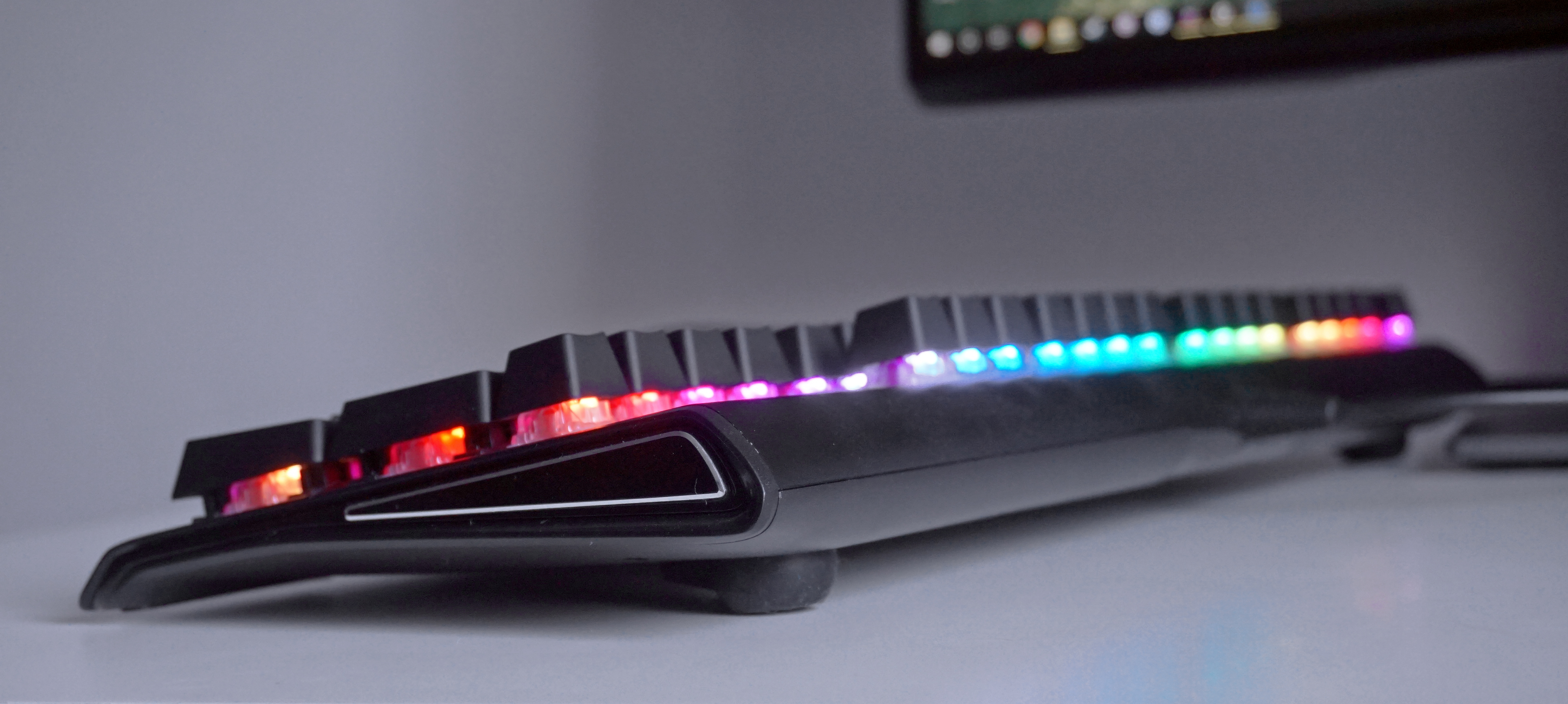Steelseries Apex M750 review: Two left feet
Base over Apex
As you may have noticed over the last year or so, I've tended to quite like Steelseries' PC peripherals. Two of their mice currently occupy top spots in my best gaming keyboard list, and their Arctis 7 headset is my favourite bestest best all time. Their top-end Apex M750 keyboard, however, won't be making any kind of best gaming keyboard list whatsoever. I've tried and tried to like this keyboard, but I simply can't get on with it. And a lot of that has to do with its weird little feet.
Almost everything about the Apex M750 should scream quality - and you'd certainly hope so given the fact it costs £150 / $130. It has a premium-feeling aluminium chassis, and Steelseries' own proprietary mechanical RGB switches feel very similar in feel and speed to Cherry's MX Red jobs - which is just what you'd want from a high-end gaming keyboard.
So it breaks my heart (and brain) to see that not only have Steelseries invented the worst keyboard feet in the world, but that they've also decided to stick them on their flagship gaming keyboard. Just look at them! Them and their weird, rubbery, dust magnet surface. They're a nightmare to attach properly in the first place, as their odd, circular bottoms never really feel like they were ever intended for the hole they're meant to be pushed into.

There were also several times when I knocked them loose while moving the keyboard across my desk, too, which only added to my overall sense of irritation. There's a reason why so many gaming keyboards have flip-down feet - because they're the stuff of gods and don't cause you to pop a vein every time you try to adjust them. Push-in feet, on the other hand, are clearly the devil's work and should be banned until the end of time.
It's not just the Apex M750's feet that upsets me, though, as I'm also apparently incapable of typing on it without making a mistake at least every four keystrokes. This review took 83x longer to write than usual because of how difficult I found it to type on, and it's a miracle there aren't any typos, to be honest.
Granted, I had less of a problem using it for gaming due to the small number of keys I had to use. But when it comes to general typing (which I always like to be able to do on any gaming keyboard I test because most people, I imagine, tend to use their PC for more than just gaming), it was absolutely catastrophic.
That's after months and months and months of use, too. And yet, in all the time I've spent trying to be the M750's friend, I've never really been able to pinpoint exactly why it makes me so prone to making such frequent, irritating mistakes. Perhaps it's because the keys feel unusually high compared to other linear-style keyboards I've used in the past. Perhaps it's because their gently curved surfaces are just a fraction too slippery to make sure I've hit the right key properly.
Or maybe it's because I'm still not used to having a single-height Enter key and resent the fact that every message I type in Slack to the wider RPS Hivemind looks like I'm trying to be cool and 'down with my fellow kids' by adding a # on the end of everything. It is, I should note, a US layout keyboard, so some of the punctuation buttons aren't in the same place as I'm used to, but even after forcing it to believe it's a UK keyboard in Windows it's still infuriating on a daily basis, and I don't think all the time in the world would be enough to finally get used to this damn thing.
It's a shame, really, as it's by far one of the less ostentatious RGB gaming keyboards I've tested in quite some time. Apart from a glossy Steelseries logo tucked away in the top right corner, there's very little embellishment to be seen elsewhere. The aluminium chassis is just plain black all the way across, and its RGB lighting doesn't spill out too far from beneath the keycaps.
Steelseries' Engine 3 software also provides more customisation options than I've seen in a long time as well, including the ability to reassign every single key to your liking. Want a number pad full of recordable macros? Or a more fully-featured Fn bar that builds on the existing media and light controls? The M750 will provide.
That's pretty generous compared to other gaming keyboards I've tested in the past, but there's no escaping the fact it's also incredibly stingy in other areas at the same time. If I'm spending £150 / $130 on a keyboard, I think I'd want one that also supports USB passthrough, for instance, or at the very least a USB port I can use to charge up my phone like the HyperX Alloy FPS RGB. Unfortunately, the Apex M750 has neither of those things.
Perhaps I'm alone in my M750 struggles, but given the amount of trouble I've had with it, I just can't recommend anyone go out and buy it over the cheaper and infinitely superior Fnatic Streak, for example, or the even more inexpensive HyperX Alloy Elite. Both of those have USB passthrough and dedicated media keys for a lot less money, and are available in a range of Cherry MX switches to suit your preferred typing and gaming style. I'm sorry, Apex M750, but it's into the bin with you.


